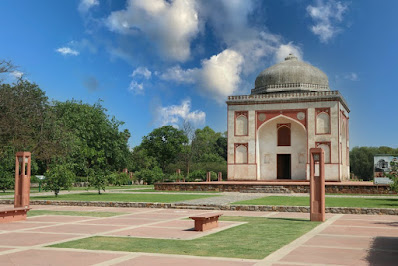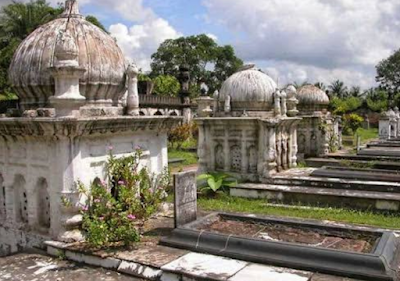Tomb of Mir Jafar:
The third tomb in the middle of the tomb from the east side belongs to Mir Jafar. He died on 5 February 1765 at the age of 74. After his death he was buried here. Although the tomb of Mirzafar is not magnificent, it is full of nobility. The tomb is surrounded by a corrugated wall about two and a half feet high. And covered with stones at the top, paved with bricks one and a half feet high.
Above it is a nameplate inscribed on a white stone. And at the head of the tomb there is a lampstand four feet high. Successors still come here on the day of his birth and death to light the lamp.
Jafarganj Cemetery :
On the way to Nasipur Rajbari, Jafarganj Prasad is on the side of the road, one and a half kilometers north of Nizam of Murshidabad fort.It is said that Alivardi Khan built the palace for his sister Shah Khanam during his Nawabi period.Mir Jafar lived here till he sat in the masnad. And this is where the brutal assassination of Sirajdaula took place.At present there is no sign of that palace. Only a fragment of the entrance still stands.Jafarganj Cemetery is located on the side of the road just east of palace.
Mir Jafar and his wife Moni Begum along with other Nawabs of his dynasty, Nazim and their Begum are buried here. The entrance to the walled cemetery on two to three acres of land is made like a one-storey house in the tomb area of Khoshbagh.However, in the case of Khoshbagh's tomb, except for the tomb of Murshid Quli Khan, the tombs are extraordinary. Mostly adjacent to the land. Some tombs, some plaques are given in such a way that it is clear that after the death of Siraj, his descendants came down to a normal stage. On the other hand, seeing the magnificent tomb of Jafarganj reminds us of the Nawabi period of Mir Jafar.Since they are still descendants of Mir Jafar, there are many tombs here. However, the cemetery is no longer preserved that way. Many tombs have been destroyed and have not been repaired. Cemeteries should be preserved in new ways.
Tomb of Humayun Jah:
In 1824, Humayun Jah, son of Nawab Waljar, became Nawab.Humayun who has built many palaces and monuments in Murshidabad. He was a very luxurious and generous person. It is heard that he used to get a scholarship of Rs 6 lakh per month. He spent a lot of money to build Humayun Manzil.The famous Hazar Duari Palace in Murshidabad was built between 1829 and 1837 AD during his reign.Murshidabad is a major tourist attraction. When Humayun died in 1838, he was buried in Jafarganj. The tomb of Nawab Humayun was quite magnificent. The top is covered with black and white stones.There is an identity board at one end of the tomb. And above the plaque is a symbolic mosque in the shape of a miniature Mughal architecture. The tiles on top of it are sitting to be ruined. The plaster of the mosque has fallen off. The condition of most of the tombs in Jafarganj is very bad. Reforms are needed now.
Cemetery of Wsaf Ali Mirza:
After the death of Nawab Hasan Ali, his son Wasif Ali Mirza became Nawab. He was Nawab from 1906 to 1959.Wasif Ali Mirza built a beautiful conch artistic palace in his own name. And was named Wasif Manzil.
He was a very generous man. And he has worked for communal harmony. After the partition of the country, no communal riots broke out in the city of Murshidabad just because of its liberal policies.
Wasif Ali Mirza's Tomb Mirzafar's family graveyard was given in Jafarganj . But The tomb could not be specifically identified because it did not have a name plate.
Tomb of Munni Begum:
The magnificent tomb of Munni Begum, the wife of Mir Jafar, is preserved in a walled courtyard a little to the north of the Mirzapur tomb.Munni Begum's life is the most colorful among the Nawab Begums of Murshidabad.
Among the Begums she was the most cunning, intelligent and far-sighted.Munni Begum died on 10 January 1813 at the age of approximately 97 years.He was buried in Jafarganj in the family social sphere of Mir Jafar. Munni Begum's tomb altar has been built in two places. At first another altar, one foot high, was built on top of a large altar about a foot and a half high. And the top of that altar is covered with white stone. On the head is the name of the inscription on the white stone.The walled enclosure around the tomb is also built in Mughal architectural style.Much like a mosque. There is a minaret on top of each arch. Munni Begum's tomb bears a distinct identity for this.
Tomb of Basanta Khan:
Nawab Nazir Basanta Khan, the chief eunuch of Mir Jafar, established Kadam Sharif or Kadamrasul in 1787, just east of the artillery, some east of the Behrampur Lalgola Road. This beautiful little mosque was preserved from the footprints of the Prophet Muhammad. Later it was again proved to be the Kadamrasul of Gaur.
The tomb of Pir Badruddin:
The tomb of Pir Badruddin is now preserved inside the mosque in the beautiful and famous mosque premises of Karbala. This mosque is known as a significant antiquity of Bahrampur i.e. Murshidabad in ancient times.The mosque was built on November 15, 1490. The then Sultan of Gaur was Mamud Shah II. He built this mosque. The name of this region was Brahmapur during the reign of Sultan Mamud Shah II.However, the local name of this region was Badarpur. Researchers believe that the name Badarpur may have come from the name of Pir Badruddin buried inside the mosque.This ancient mosque of Karbala was in a state of disrepair for a long time. The mosque was rebuilt for the second time in the mid-twentieth century. It was renovated between 1993 and 1994, leaving no trace of the old artistic tradition.
Very recently the mosque has been renovated and rebuilt. The surrounding courtyard of the mosque is made of concrete. Roads have been constructed from the main road of Karbala to the mosque. The Karbala Mosque and the mosque precincts have been redecorated, only the old archeological monuments have been lost.However, the tomb of Pir Badruddin has been beautifully preserved inside the mosque. Surrounded by steel railings. The shrine is covered with Makmal cloth. The area was once depopulated but is now inhabited. Also on the west side of the mosque is a huge public grave.












0 Comments
Have a any query, please let me know